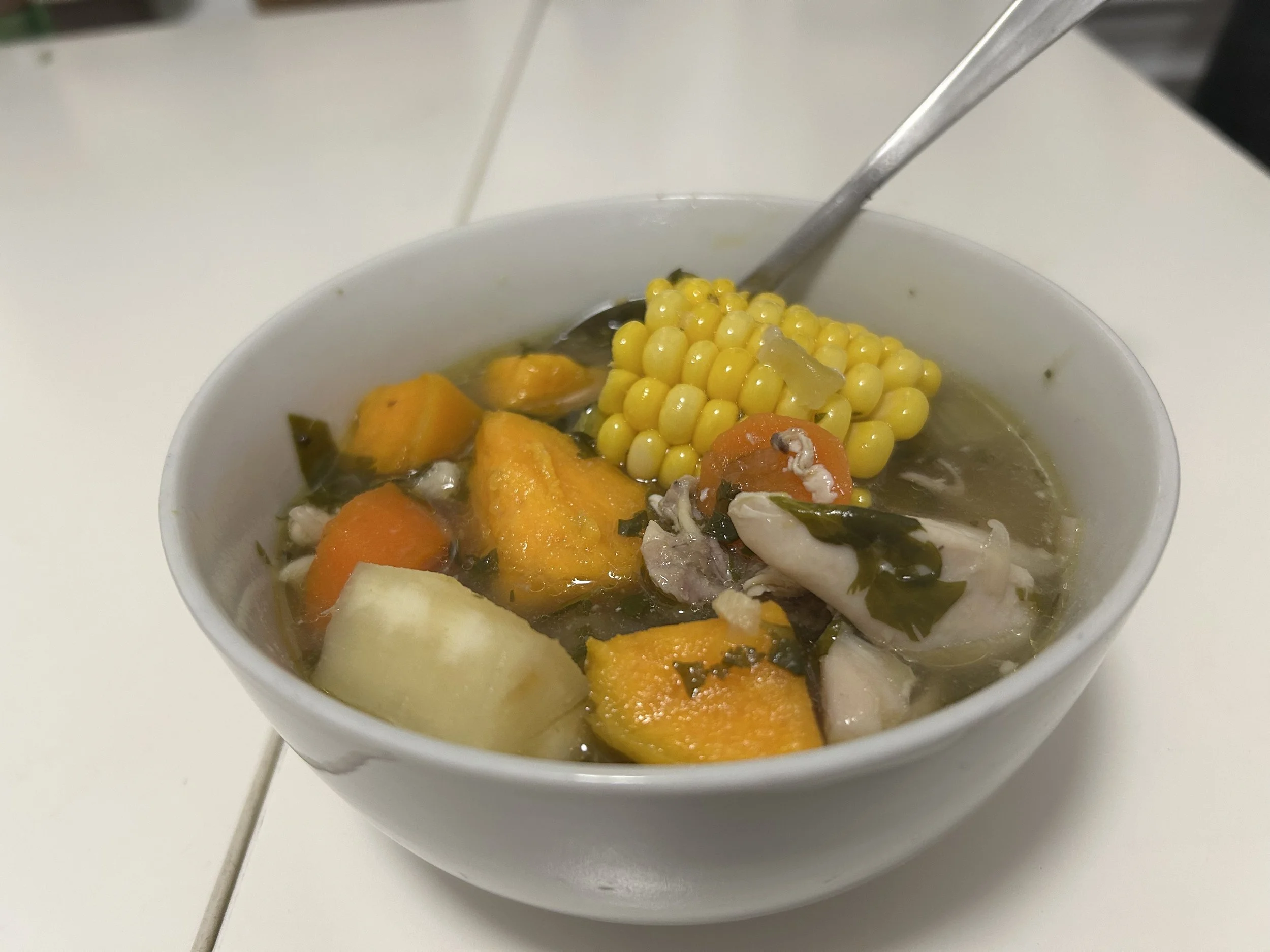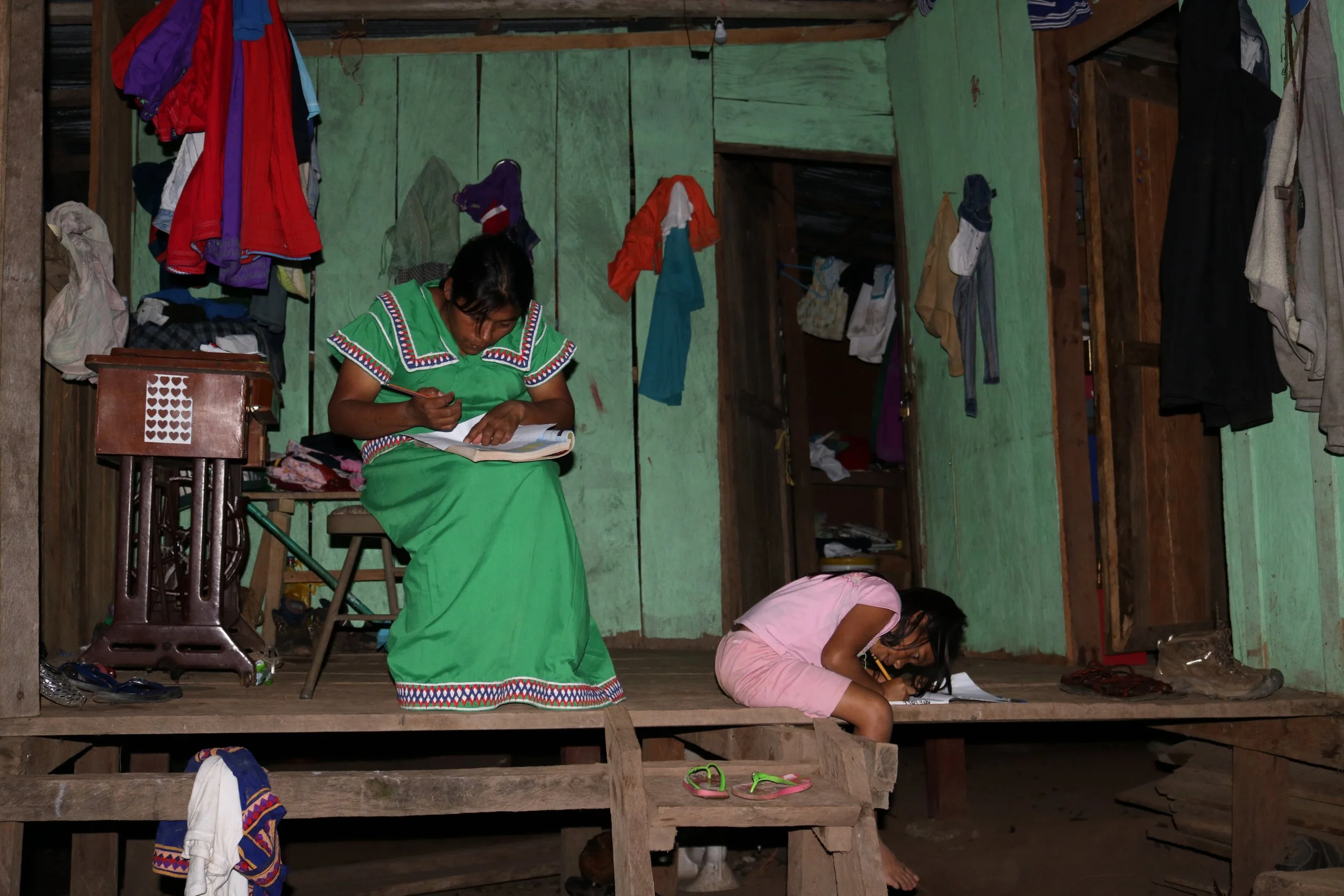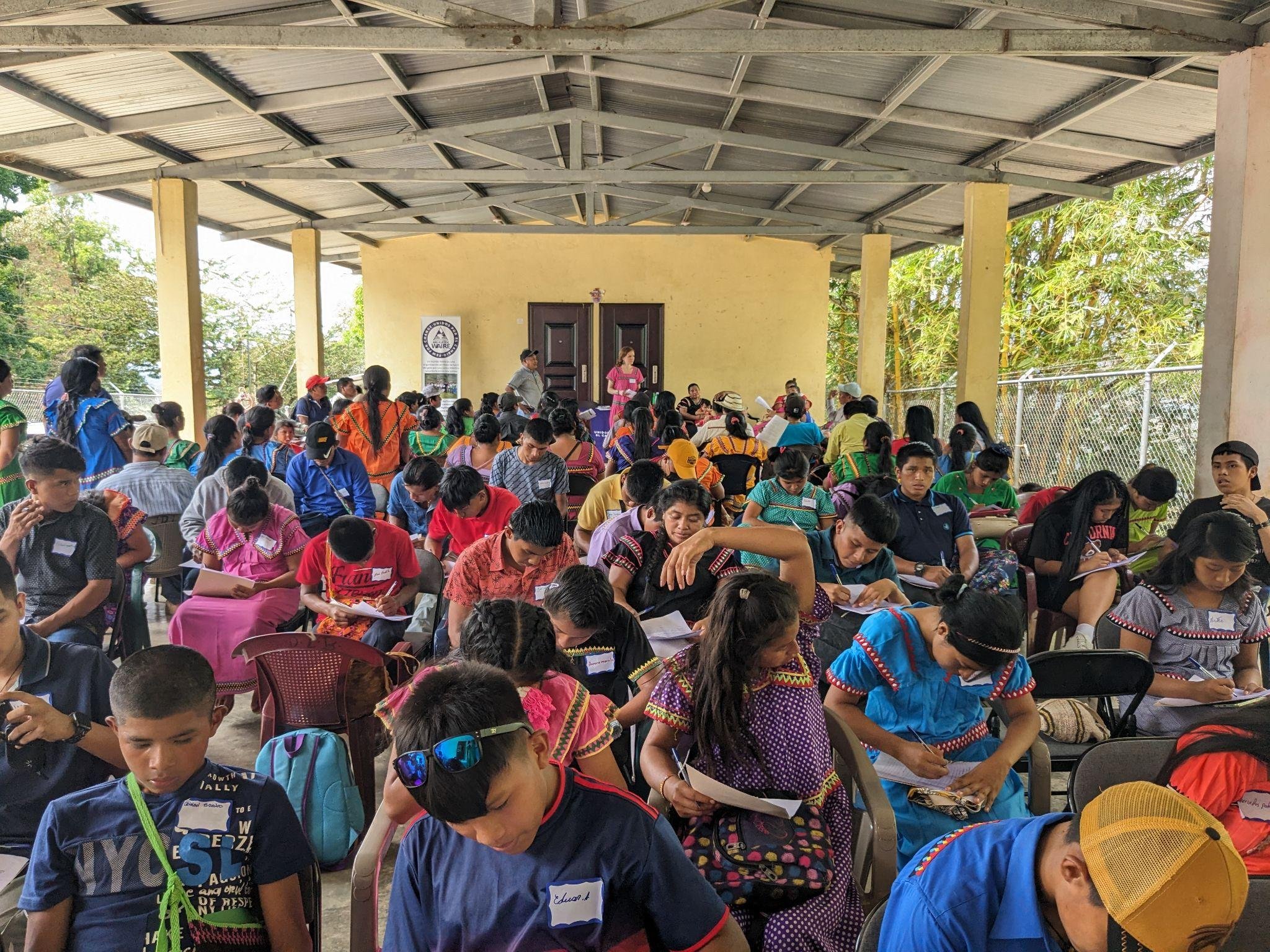This guest post from Education Access Fellow Katya Sparks presents the data analysis of 10+ years of report cards received by Few for Change from Few for Change scholarship recipients.
The Comarca Ngäbe-Buglé is located in Western Panama and is home to more than 250,000 indigenous people who are known by the name Ngäbe-Buglé. The comarca is characterized by mountainous terrain with steep slopes, small streams, and large rivers. Most travel in the comarca is done on foot or horseback as there are few year-round access roads leading into the comarca.
A woman and child cross a bridge while children play near a stream.
The insufficient infrastructure in the Comarca Ngäbe-Buglé and the remoteness of the region is a challenge for Ngäbe-Buglé children. It can take anywhere from 30 minutes to 3 hours for children to walk to school in the comarca and the path can be treacherous. In recent years, students have been killed after getting hit by rockslides [1] or drowned [2] on their way to and from school. Covering the cost of transportation to schools is also a concern for families as people in the comarca make less than $3 per day on average [3].
Few for Change was founded in 2009 by a group of college students who participated in a study abroad program in Panama. During their semester in Panama, the college students visited the Comarca Ngäbe-Buglé. Their moving experience in the comarca and the generosity that the Ngäbe-Buglé people showed them inspired the college students to start Few for Change. Read more about how Few for Change got started here.
In 15 years, Few for Change has awarded over 125 scholarships. Few for Change volunteers look at report cards and essays from scholarship recipients each year to determine which students will receive a Few for Change scholarship. During my time as an Education Access Fellow, I analyzed more than 200 report cards from 84 Few for Change scholarship recipients between 2010 and 2021. This research shows that the barriers that stand in the way of Few for Change scholarship recipients don’t stop them from succeeding in school.
Here are the takeaways from my research:
Figure 1. The 24 schools in Panama that Few for Change recipients have attended since the inception of Few for Change.
1. Most students apply for a Few for Change scholarship while attending school in the Comarca Ngäbe-Buglé
Few for Change has received the most applications from students who attend school in the Comarca Ngäbe-Buglé. Many students learn about Few for Change through promotores, or promoters, who help communities in the comarca access resources and services to improve the quality of life in the region. Promotores at Few for Change also serve on the junta directiva, or board of directors, and take on additional leadership roles throughout the comarca. They know their communities well, and their cultural and linguistic competence is crucial in building awareness about Few for Change and supporting students. The promotores are so influential that Few for Change has even received a number of scholarship applications with essays written about the promotores and the impact that they have made in students’ lives!
Figure 2. The percentage of Few for Change recipients based on the province where they attended school at the time of a Few for Change scholarship application submission.
2. School demands more from students when entering a new grade level
The transition from primaria (grades K-6) to pre-media (grades 7-9) and the transition from pre-media to media (grades 10-12) are difficult for students as the risk of grade repetition and school dropout intensifies for each change in level. The situation is not limited to students in the Comarca Ngäbe-Buglé, but students throughout Panama as well [4].
Students have to adapt to new professors, many courses, and a heavy workload as they transition from primaria to pre-media and from pre-media to media. In addition, there are fewer schools past the primaria and pre-media level. Students who live in rural communities and students who live in a comarca have the highest proportions of exclusion as school availability in these areas is limited [4].
Figure 3. The overall grade point average (GPA) in the report cards across grade levels.
3. Over 1/3 of students transfer to a school in a different province
Among Few for Change recipients, over 1/3 of students transfer to a school in a different province after receiving a Few for Change scholarship (Figure 4). According to MEDUCA, the Panamanian Ministry of Education, 64% of students at the primaria level attend schools that do not offer pre-media and 47% of students at the pre-media level attend schools that do not offer media [4]. As a consequence, some students must travel further to attend another school to continue their studies at the end of 6th grade and 9th grade, respectively.
Figure 4. The percentage of Few for Change recipients who transferred schools after receiving a Few for Change scholarship.
Escuela Buena Vista is a school in the Comarca Ngäbe-Buglé that offers schooling at the primaria (grades K-6) and the pre-media level (grades 7-9).
4. Among Few for Change recipients who transfer to a school in a different province, the majority transfer to a different school in the 10th grade
According to MEDUCA, 30% of young people aged 15 to 18 years old who do not attend school gave the following as the main reason: "Grade level is not offered in the community.”[4] While there are schools in the Comarca Ngäbe-Buglé that offer the media level, the lack of school availability is exacerbated by the fact that not all schools that offer media in the comarca offer the same bachilleratos, or specializations. As a result, students who attend media and wish to pursue a particular bachillerato may have to travel up to 3 hours to go to school. Alternatively, students may need to rent a room during the school week which is an enormous financial burden for families as more than 90% of residents in the comarca live in poverty [5].
Figure 5. The percentage of Few for Change recipients who transferred to a different school after receiving a Few for Change scholarship by grade level.
5. More than half of Few for Change recipients have attended the 9th grade
The percentage of teens ages 15-19 in the Comarca Ngäbe-Buglé that had schooling beyond the 6th grade is 18% [6]. Out of 84 Few for Change recipients, 52% have attended the 9th grade (Figure 6). This difference shows that Few for Change is playing a positive role in changing the lives of students from the comarca and helping them continue their education. Our scholarships work!
Figure 6. The number of report cards submitted to Few for Change across grade levels. A student may have submitted either one report card or numerous report cards depending on the number of years the student was awarded a Few for Change scholarship.
Conclusion
In the last 15 years, Few for Change has awarded over 125 scholarships to students from the Comarca Ngäbe-Buglé. As we continue to evolve, we plan to continue supporting students from the comarca by providing more scholarships and by developing mentorship programs and motivational workshops that supplement their schooling. With a focus on students at the media level, the goal is to help more students from the Comarca Ngäbe-Buglé graduate with a high school diploma so that students can continue to make an impact in their community and beyond. You can help us grow our programming by making a donation to our general fund here.
Sources
[1] De Tvn Noticias, Redacción. “Niño Muere Tras Ser Golpeado Por Una Roca Que Se Desprendió De Un Cerro En La Comarca Ngäbe-Buglé - Nacionales | Tvn Panamá.” Tvn Panamá, 19 Apr. 2023, www.tvn-2.com/nacionales/nino-muere-golpeado-roca-desprendio-cerro-comarca-Ngäbe-Buglé-meduca-tragedia_1_2047524.html
[2] Madrid, Mayra. “Menor Muere Ahogado Cuando Regresaba De La Escuela En La Comarca Ngäbe-Buglé.” Panamá América, 7 Sept. 2022, www.panamaamerica.com.pa/provincias/menor-muere-ahogado-cuando-regresaba-de-la-escuela-en-la-comarca-Ngäbe-Buglé-1211759.
[3] Telemetro. (2017, May 17). Presentan Mapa de Pobreza en Panamá, índice Se Redujo. TeleMetro.com. https://www.telemetro.com/nacionales/2017/05/17/presentan-mapa-pobreza-panama-disminucion/1285740.html
[4] UNICEF. (2022). Niñez fuera de la escuela y en riesgo de exclusión educativa en Panamá. https://www.unicef.org/panama. https://www.unicef.org/panama/media/6086/file/Ni%C3%B1ez%20fuera%20de%20la%20escuela%20y%20en%20riesgo%20de%20abandono%20escolar%202022.pdf
[5] Diéguez, J. "Mapas de pobreza y desigualdad a nivel de distrito y corregimiento: Encuesta de propósitos múltiples de 2011 y censo de población y vivienda 2010 [Maps of poverty and inequality at district and township level: Multiple purpose survey of 2011 and population and housing census 2010]." Panama City, Panama: Ministerio de Economía y Finanzas (2015).
[6]Minority Rights Group International, World Directory of Minorities and Indigenous Peoples - Panama : Guaymi (Ngobe-Bugle), December 2008, available at: https://www.refworld.org/docid/49749cce1e.html [accessed 3 February 2024]




















